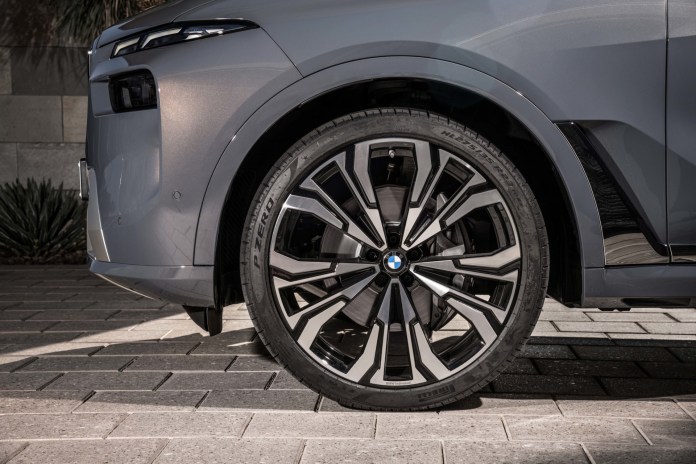
BMW was one of the first companies to raise eyebrows by introducing an SUV back in 2000 with the introduction of the first X5, which it called Sport Activity Vehicle. Since then, everyone has catered to the SUV craze, including companies that you would never imagine doing so, such as Rolls Royce, Maserati, Lamborghini and Bentley. Since that first X5, BMW has invested heavily in SUVs, with many different models, and more keep coming out. Today you can select from a huge range of BMW SUVs ranging in size from small to large and all with engines ranging from fuel sipping four cylinders to twin turbo V8s to hybrids to full electrics.

The X7 is the largest of the X line and is full of luxury features you would expect in such a vehicle. Unlike some of the other X models, there is no M version of the X7. You get a choice of two different engines. Standard is a 3.0-liter turbocharged inline six that puts out 375 horsepower. The optional engine is a 4.4-liter turbocharged V8 that ups the power output to 523. There is a special upgrade that should be mentioned. There is also an Alpina XB7 version of the X7 that has been tuned by Alpina engineers to its drivetrain philosophy of enormous power and prodigious low-RPM torque. As a result, the 4.4-liter bi-turbo V8 in the XB7 produces 630 horsepower and 590 pound-feet of torque. That is enough to launch the XB7 from 0-60 mph in an explosive 4.0 seconds, on to a maximum speed of 180 mph. But we are not here to talk about the Alpina.
Our car featured the inline six engine, which has received many improvements. Making its debut in the new BMW X7 xDrive40i, the 3.0-liter inline six-cylinder engine boasts a wealth of innovations in the combustion process, gas exchange, valve control, injection and ignition system. Its maximum output of 375 horsepower is up by 40 over its predecessor, while peak torque rises by 52 pound-feet to 383 and can be boosted to as much 398 pound-feet with the assistance of the mild hybrid system.
The Miller cycle shortens the opening time of the intake valves, which subsequently leads to an increase in the effectiveness of the turbocharging system and the intercooler. This reduces fuel consumption and emission levels significantly across the entire load range. The fully variable valve control now includes a switchable rocker arm on the exhaust side, which allows gas exchange to be interrupted, if required. This means that when the driver releases the accelerator, a higher proportion of the braking energy can be absorbed by the mild hybrid system’s generator and fed into the 48V battery by means of recuperation.

The VANOS variable camshaft timing now works electrically. This means the adjustment range can be expanded to minimize emissions even further. Power development and emissions also benefit from a new exhaust manifold integrated into the cylinder head. The new engine changes result in an X7 that can accelerate from 0 to 60 mph in an estimated 5.6 seconds.
The BMW X7 is expected to still handle like a BMW, and for such a large SUV, it does a remarkable job. It’s worth noting that it has a double-wishbone suspension up front rather than McPherson struts. Renowned for exceptional comfort, the adaptive two-axle air suspension works with electronically controlled dampers to deliver BMW dynamic prowess combined with excellent comfort on long journeys. Standard specification for the V8 and optional on the six cylinder modes is Integral Active Steering and active roll stabilization.

Throw the X7 into a corner and you will be surprised about how such a big SUV can handle so well. The electronics do step in to control the chaos and will take away the throttle from you, but it is done in a gentle manner and most people will never notice it anyway.
The X7 is about luxury and it has so many features that will make your head spin. The curved 14.9-inch display in front of the driver controls everything. There are beautiful illuminated light bars on the doors and dash with X7 graphics. Luxury also means comfort and quiet, and the X7 is a great long distance cruiser, although we did hear a bit of wind noise from the outside mirrors.

Luxury is not cheap, and X7 prices are not for everyone. Our xDrive40i model starts at $82,000 but add in a options that you will inevitably end up with and our test car was around $95,000. If you want the bigger engine, be prepared to spend another $20,000 on top of that.
Specifications
| Engine: | Turbocharged 3.0-liter six-cylinder |
| Horsepower: | 375 @ 6,250 rpm |
| Torque: | 383 pound-feet @ 1,850 rpm |
| Front Suspension: | Double wishbone |
| Rear Suspension: | Multilink strut |
| Transmission: | Eight-speed automatic |
| Axle Ratio: | 3.64:1 |
| Curb Weight: | 5,060 lbs. |
| Base MSRP: | $78,845 |






















